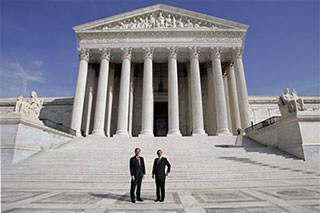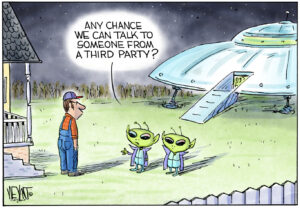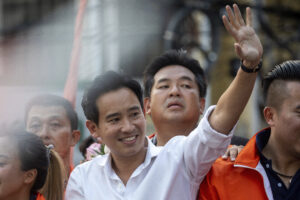Voter Suppression and John Roberts’ New World Order
Whatever petition the Supreme Court decides to take up, the suppression movement will find a welcome setting.
As the presidential campaign heads for the stretch, the political and legal battles over voter suppression are also coming to a head. To understand the unfolding class warfare — and that’s exactly what it is — it’s important not just to grasp the specifics of the many suppression schemes sweeping the nation. It’s vital to place those schemes in the larger context of the American right’s long-cherished goal of redrafting the nation’s legal architecture and forging a new corporate political order.
Consider the specifics first. According to the Brennan Center for Justice, since the start of 2011, 16 states — accounting for 214 electoral votes — have passed restrictive voting laws. Each law is different, with states such as Florida seeking to curb voter registration drives and others such as South Carolina, Texas, Wisconsin and Pennsylvania imposing new requirements on voters to produce government-issued photo IDs at the polls.
The laws raise different technical legal issues. States such as Texas and South Carolina, with a legacy of discrimination against the electoral rights of minorities, are required to obtain “preclearance” from the Justice Department or the courts under Section 5 of the Voting Rights Act before implementing new laws. States such as Pennsylvania and Wisconsin, under the direction of Republican governors, only recently entered the suppression arena and don’t require preclearance but are still subject to the general anti-discrimination provisions of the act. Pennsylvania is among the few states that also recognize the right to vote under their own constitutions and thus offer opponents additional grounds to bring legal challenges.
Details aside, the scope of the suppression movement and its potential impact are staggering. The Brennan Center reports that as many as 11 percent of eligible voters — roughly 21 million Americans — lack current, unexpired government-issued photo IDs. The percentages are even higher among seniors, African-Americans and other minorities, the working poor, the disabled and students –constituencies that traditionally skew Democratic and whose disenfranchisement could prove decisive in any election.
Given the absence of any credible evidence of widespread voter fraud (the Bush administration ended a five-year witch hunt in 2007 with a mere 86 convictions), it’s not surprising that suppression opponents in Florida, Texas, Pennsylvania and elsewhere have filed a myriad of lawsuits to delay, block and overturn various recently enacted suppression laws. No doubt there are many trial judges of good will and integrity who will find merit in such challenges. Decisions on both the Pennsylvania and Texas ID laws are expected in the next few weeks.
But with the exception of rulings based solely on state law, as may prove to be the case in Pennsylvania, any justice opponents receive in the lower courts will likely prove temporary, pending an inevitable review by the Supreme Court. Indeed, there are already petitions from North Carolina and Alabama before the court that seek to invalidate Section 5 of the Voting Rights Act. So Supreme Court review isn’t a matter of if, but when.
Whatever petition the Supreme Court decides to take up, the suppression movement will find a welcome setting. In 2008, in a 6-3 decision that may rank as the most shortsighted ever authored by former Justice John Paul Stevens, the court upheld Indiana’s highly restrictive voter ID law (Crawford v. Marion County Election Board).
In 2009, in a case involving a Texas utility district with an elected board that had sought an exemption from Section 5’s preclearance requirement, the court sidestepped a direct ruling on the provision’s constitutionality but nonetheless noted that the preclearance rule raises “serious constitutional questions” (Northwest Austin Municipal Utility District No. 1 v. Holder). Last term, in another Texas case, the court overturned a lower-court order that had voided a racially biased statewide redistricting plan (Perry v. Perez).
The stage is thus set for a full-scale constitutional attack on Section 5 and perhaps other aspects of the Voting Rights Act. But as devastating as that development would be on its own, gauging the full measure of the act’s demise requires a broader perspective that, at a minimum, connects the suppression movement to two other lines of court decisions aimed at reshaping American law and politics: Citizens United v. Federal Election Commission and its progeny, and the Roberts court’s virulently anti-labor jurisprudence.
Under the guise of formal equality, the court in Citizens United held that corporations, unions and individuals possess the same First Amendment rights to make “independent” expenditures (those that are not directly coordinated with candidates) on political campaigns. Shortly afterward, the U.S. Court of Appeals in D.C. followed with a ruling that such expenditures — typically made to what have come to be called super PACs and even more shadowy nonprofits — may be unlimited (SpeechNow.org v. FEC). And to round out the edges of the corporate personhood doctrine and prevent states from carving out local exceptions to Citizens United, the Roberts court in June declared a Montana law limiting political spending by corporations unconstitutional (American Tradition Partnership, Inc. v. Bullock).
From the outset, the formal legal equality announced in Citizens United masked a fundamental inequality in the court’s views on how corporations and unions actually go about raising and disbursing political action funds. Whereas corporations are free to spend their assets on politics even if individual shareholders don’t want them to, in a series of decisions since 2007 and continuing with this term’s opinion in Knox v. Service Employees International Union, Local 1000, the court has endorsed right-to-work laws, lambasted union dues as “coercive,” and made it increasingly onerous for public employee unions — the last bastions of organized labor — to keep up with their corporate counterparts in financing political causes.
With the anticipated triumph of voter suppression, the American right will finally achieve the new political order it has long craved — a trifecta of institutionalized class domination in which (1) the poor, the elderly and minorities in large numbers are denied the right to vote; (2) labor unions are crippled; and (3) massive corporations — considered “people” under the law and set free to spend unlimited sums to rig the outcome of elections — have become the only “people” who matter.
The question that remains is how long we, the other people, will permit the new order to endure.
Your support matters…Independent journalism is under threat and overshadowed by heavily funded mainstream media.
You can help level the playing field. Become a member.
Your tax-deductible contribution keeps us digging beneath the headlines to give you thought-provoking, investigative reporting and analysis that unearths what's really happening- without compromise.
Give today to support our courageous, independent journalists.






You need to be a supporter to comment.
There are currently no responses to this article.
Be the first to respond.